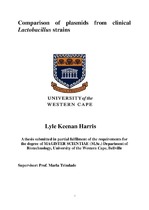| dc.contributor.advisor | Trindade, Marla | |
| dc.contributor.author | Harris, Lyle Keenan | |
| dc.date.accessioned | 2018-10-03T08:17:33Z | |
| dc.date.available | 2018-12-31T22:10:06Z | |
| dc.date.issued | 2018 | |
| dc.identifier.uri | http://hdl.handle.net/11394/6439 | |
| dc.description | Magister Scientiae - MSc (Biotechnology) | |
| dc.description.abstract | The vaginal mucosa is dominated by Gram positive, rod shaped lactobacilli which serve as a
natural barrier against infection. In both healthy and BV infected women Lactobacillus
crispatus and Lactobacillus jensennii has been found to be the predominant Lactobacillus
species. Many studies have been conducted to assess factors influencing lactobacilli dominance
in the vaginal microbiome. However, no study has evaluated the impact of plasmids on the
vaginal lactobacilli. In the present study two plasmids, pLc17 and pLc4, isolated from vaginal
Lactobacillus species of both healthy and BV infected women were characterized. pLc4 was
present in both Lactobacillus crispatus and Lactobacillus jensennii while pLc17 was only
present in Lactobacillus crispatus. pLc17 (16663 bp in size) encoded a ribonucleotide
diphosphate reductase (RNR), a filamentation induced by cAMP-like (FIC-like) protein and
numerous mobile elements. | |
| dc.language.iso | en | |
| dc.publisher | University of the Western Cape | |
| dc.subject | vaginal mucosa, Gram positive, rod shaped lactobacilli, Lactobacillus crispatus, Lactobacillus | |
| dc.title | Comparison of plasmids from clinical Lactobacillus strains | |
| dc.rights.holder | University of the Western Cape | |

